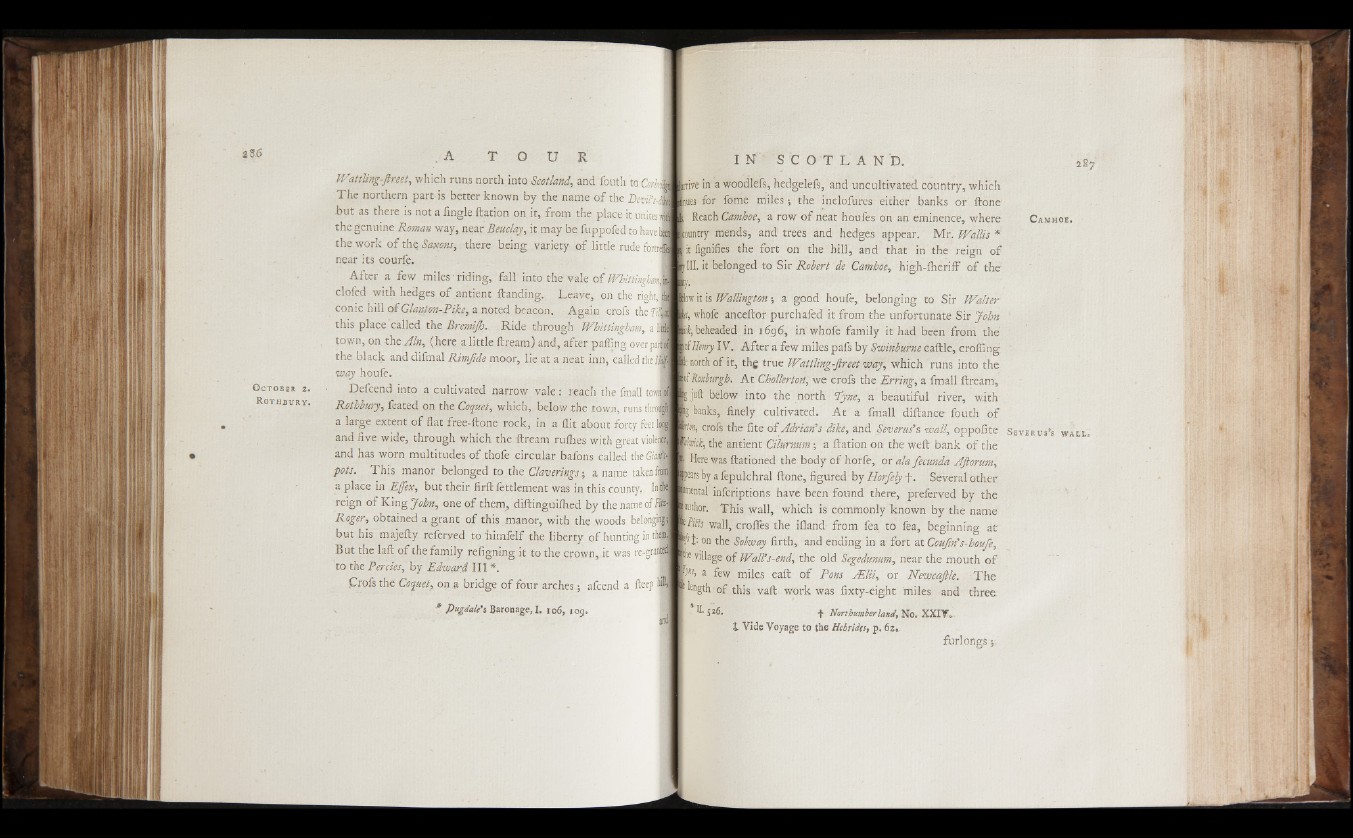
O c t o b e r 2.
R o t h b u r y .
H,
Wattling-ftrjet, which runs north into Scotland, and fouth to Corhl
The northern part is better known by the name of the BevihJL
but as there is not a fingle ftation on it, from the place it unites J
the genuine Roman way, near Beuclay, it may be fuppofed to have baf
the work of the Saxons, there heing variety of little rude fortrel
near its courfe.
After a few miles ■ riding, fall into the vale of WhittmghmJ
clofed with hedges of antient Handing. Leave, on the right, tif
conic hill of Glanton-Pike, a noted beacon. Again crofs the ?///!
this place called the Bremijh. Ride through Whittingham, a lira
town, on the Ain, (here a little ftream) and, after palling over paiiof
the black and difmal Rimfide moor, lie at a neat inn, called the llm
•way houfe. .
Defcend into a cultivated narrow vale: reach the fmall towaol
Rothbury, feated on the Coquet, which, below the town, runs througl
a large extent of flat free-ftone rock, in a flit about forty feet loiig
and five wide, through which the ftream rulhes with great violence]
and has worn multitudes of thofe circular bafons called the G/n*
pots. This manor belonged to the Claverings; a name taken frojil
a place in Ejjex, but their firft fettlement was in this county.. Intbtj
reign of King John, one of them, diftinguilhed by the name of M
Roger, obtained a grant of this manor, with the woods belonging
but his majefty referyed to iiimfelf the liberty of hunting in the*
But the laft of the family refigning it to the crown,.it was re-granted
to the Percies, by Edward III *.
Profs the Coquet, on a bridge of four arches ; afcend a fteep
' P ugdalt’s Baronage, I. 106, lo g .
and;
wive in a woodlefs, hedgelefs, and uncultivated country, which
jines for fome miles; the inelofures either banks or ftone'
, Reach Camhoe, a row of neat houfes on an eminence, where
tountry mends, and trees and hedges appear. Mr. Wallis *
it ftgnifies the fort on the hill, and that in the reign of
f ill, it belonged to Sir Robert de Camhoe, high-fheriif of the
C amhoe .
it is Wallington •, a good houfe, belonging to Sir Walter
t, whofe anceftor purchafed it from the unfortunate Sir John
id, beheaded in i6g6, in whofe family it had been from the’
[of Henry IV. After a few miles pafs by Swinburne eaftle, crofting 1 north of it, thg true Wattling-Jlreet way, which runs into the
•gh. At Chollerton, we crofs the Erring, a fmall ftream,
j> juft below into the north Tyne, a beautiful river, with
banks, finely cultivated. At a fmall diftance- fouth of
pw, crofs the fite of Adrian’s dike, and Severn/s wall, oppofite S e v er u s ’s w a l l .
«the antient Cilurmm; a ftation on the weft bank of the
Here was ftationed the body of horfe, or ala fecunda AJtorum,
bears by a fepulchral ftone, figured by Horfely -|-. Several other
mental infcriptions have been found there, preferved by the
Jtuthor. This wall, which is commonly known by the name
\fids wall, crofles the ifland- from fea to fea, beginning at'
on the Solway firth, and ending in a fort at Coujln’s-houfe,
* village of Wall’s-end, the old Segedunum, near the mouth o f
F11, a few miles eaft of Pons Ailii, or Newcajlle. The
length - of this vaft work was fixty-eight miles and three
+ Northumberland, No. X X IV .
t Vide Voyage to the Hebrides, p. 62,
furlongs 5,